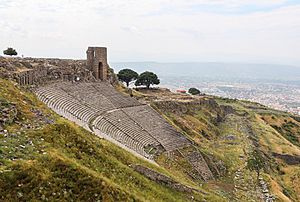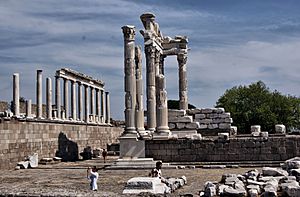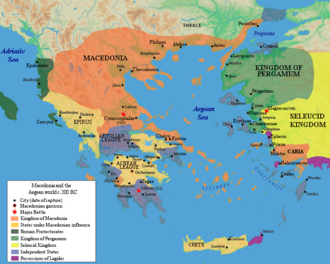Kingdom of Pergamon facts for kids
Quick facts for kids
Kingdom of Pergamon
|
|||||||||||
|---|---|---|---|---|---|---|---|---|---|---|---|
| approx. 282 BC–129 BC | |||||||||||

Pergamon in 188 BC
|
|||||||||||
| Capital | Pergamon (modern-day Bergama, İzmir, Turkey) |
||||||||||
| Common languages | Greek Lycian, Carian, Lydian |
||||||||||
| Religion | Greek Polytheism, Hellenistic Religion | ||||||||||
| Government | Monarchy | ||||||||||
| Basileus | |||||||||||
|
• 282–263 BC
|
Philetaerus | ||||||||||
|
• 263–241 BC
|
Eumenes I | ||||||||||
|
• 241–197 BC
|
Attalus I | ||||||||||
| Historical era | Hellenistic period | ||||||||||
|
• Philetaerus takes control of the city of Pergamon
|
approx. 282 BC | ||||||||||
|
• Attalus III bequeathed the kingdom to the Roman Republic
|
133 BC | ||||||||||
|
• Incorporated into Roman province of Asia after the defeat of Eumenes III Aristonicus
|
129 BC | ||||||||||
|
|||||||||||


The Kingdom of Pergamon was an ancient Greek state. It was located in the western part of Anatolia (modern-day Turkey). Its capital city was Pergamon. This kingdom was ruled by the Attalid dynasty.
The kingdom started around 282 BC. It was formed from land once controlled by Lysimachus. He was a general who served Alexander the Great. One of Lysimachus's officers, Philetaerus, took control of the city of Pergamon. Lysimachus died soon after.
At first, Pergamon was somewhat under the control of the Seleucid Empire. But it quickly became independent. It was a monarchy, meaning it was ruled by a king. The Attalid family ruled Pergamon for about 150 years. The kingdom eventually became part of the Roman Republic between 133 and 129 BC.
Contents
History of the Kingdom of Pergamon
From Independence to a Powerful Kingdom (282–241 BC)
Philetaerus started out as a trusted officer for Lysimachus. Lysimachus was one of Alexander the Great's generals. Philetaerus was in charge of the fortress of Pergamon. He also guarded a lot of Lysimachus's treasure.
Around 281 BC, Philetaerus decided to break away from Lysimachus. He was worried about Lysimachus's wife, Arsinoe. Soon after, Lysimachus was killed in battle. Another general, Seleucus I Nicator, defeated him.
Philetaerus then offered his help to Seleucus. Even so, Pergamon kept a lot of freedom. Philetaerus made friends with nearby cities. He sent soldiers, money, and food to help the city of Cyzicus. This was when the Gauls were attacking. This made Philetaerus and his family well-respected.
He also built important structures in Pergamon. These included the temple of Demeter and the temple of Athena. Athena was the city's special goddess. He also built Pergamon's first palace. Philetaerus made the city's defenses much stronger.
When Philetaerus died in 263 BC, his nephew Eumenes I took over. Eumenes I fought against the Seleucid king Antiochus I Soter. He won a battle in 261 BC. This victory made Pergamon truly free. Eumenes I greatly expanded Pergamon's land. He set up military bases to protect the new borders. He also started minting coins with Philetaerus's image.
Attalus I Soter: The Savior King (241–197 BC)
Attalus I became king after Eumenes I. Early in his rule, he won a big battle against the Galatians. The Galatians were a Celtic group living in Asia Minor. This victory was very important for Attalus. It showed he was a strong leader, like Alexander the Great.
After this win, Attalus took the name Soter, which means "Savior." He also officially took the title of basileus, meaning "king." This showed Pergamon was now a powerful kingdom.
Later, a "War of the Brothers" happened in the Seleucid Empire. This was between Seleucus II Callinicus and Antiochus Hierax. Antiochus Hierax teamed up with the Galatians. Around 230 BC, Antiochus and the Galatians attacked Pergamon. Attalus defeated them in several battles.
After Antiochus Hierax died, Attalus gained control of many Seleucid lands. These lands were north of the Taurus Mountains. The kingdom of Pergamon grew to be very large. It covered over 143,000 square kilometers (about 55,000 square miles).
However, this expansion did not last long. In 223 BC, a Seleucid general named Achaeus took back much of the lost land. Attalus was forced to retreat to Pergamon's city walls. But Attalus later allied with Antiochus III the Great. Together, they defeated Achaeus. Attalus got his lands back.
The Attalid kings became close friends with the Roman Republic. They helped Rome in many wars. Attalus I supported the Romans in the First Macedonian War and the Second Macedonian War.
Pergamon's Golden Age (197–138 BC)
When Eumenes II became king in 197 BC, Pergamon was facing challenges. The Seleucid king Antiochus III had taken some of Pergamon's territory. Eumenes II made alliances with other Greek states. He also strongly supported Rome in the Roman–Seleucid War (192–188 BC).
After Rome won the war, the Treaty of Apamea was signed in 188 BC. Rome took land from the defeated Antiochus III. They gave a huge amount of this land to Pergamon. This made Pergamon much larger and more powerful. It gained control over regions like Mysia, Lydia, Phrygia, and Pamphylia. Later, Rome also gave Pergamon more land in the southwest.
During Eumenes II's rule, Pergamon also fought other wars. They fought the Galatian War and wars against kings of Bithynia and Pontus. Eumenes II also helped Rome in the Third Macedonian War.
Eumenes II was sick for the last ten years of his life. His brother, Attalus II, took over many duties. Attalus II became king in 159 BC. He was a skilled military leader. He fought in the Battle of Magnesia, a big Roman victory. He also led troops in the Galatian War.
As king, Attalus II fought against Prusias II of Bithynia. He founded new cities, Philadelphia and Attalia. He helped Alexander Balas become king of the Seleucid Empire. Attalus II also helped Nicomedes II Epiphanes take the throne of Bithynia. He continued to support Rome in the Fourth Macedonian War.
The Final Years (138–129 BC)
Not much is known about the last Attalid king, Attalus III. Ancient writings mostly talk about his personality. He continued to defend the kingdom and supported religious projects.
Attalus III had no children. When he died in 133 BC, he left his kingdom to the Roman Republic in his will. The Romans were not eager to take on the territory right away.
A man named Aristonicus then appeared. He claimed to be the secret son of Eumenes II. He took the name Eumenes III. He tried to take control of the kingdom. He even recruited slaves to join his army.
Rome sent an army against him in 131 or 130 BC, but it was defeated. However, a second Roman army defeated Eumenes III in 129 BC. The Romans then officially took over the former Kingdom of Pergamon. It became the Roman province of Asia.
Art and Culture
The Pergamon Altar is a famous structure from Pergamon. Inside it, there is a long carving called a frieze. This frieze shows the life of Telephus. Telephus was the son of the demigod Herakles. The ruling Attalid family connected Telephus to their city. They used him to claim a connection to the Greek gods. Pergamon was a newer Greek state. So, it created its own stories to fit into Greek mythology.
Territory
-
Pergamon's expansion after the Roman victory in the Roman–Seleucid War. Rome wanted to weaken the Seleucids by giving land to Pergamon, their ally.
Dynasty of Pergamon
| Attalid dynasty Δυναστεία των Ατταλιδών
|
|
|---|---|
| Country | Kingdom of Pergamon |
| Current region | Western Asia Minor |
| Place of origin | Paphlagonia |
| Founder | Philetaerus |
| Final ruler | Attalus III |
| Final head | Eumenes III |
| Deposition | 133 BC |
Here are the rulers of the Kingdom of Pergamon:
- Philetaerus (282–263 BC)
- Eumenes I (263–241 BC)
- Attalus I Soter (241–197 BC)
- Eumenes II (197–159 BC)
- Attalus II Philadelphus (159–138 BC)
- Attalus III (138–133 BC)
- Eumenes III Aristonicus (pretender, 133–129 BC)
Attalid Family Tree
| Attalus ∞ Boa |
|||||||||||||||||||||||||||||||||||||||||||||||||||||
| Philetaerus ruler of Pergamon 282-263 BC |
Eumenes ∞ Satyra |
Attalus | |||||||||||||||||||||||||||||||||||||||||||||||||||
| Eumenes I ruler of Pergamon 263-241 BC |
Philetaerus (?) | Attalus ∞ Antiochis |
Eumenes (?) | ||||||||||||||||||||||||||||||||||||||||||||||||||
| Attalus I Soter king of Pergamon 241-197 BC |
Apollonis | ||||||||||||||||||||||||||||||||||||||||||||||||||||
| (?) | Eumenes II Soter king of Pergamon 197-159 BC |
Stratonice daughter of Ariarathes IV of Cappadocia |
Attalus II Philadelphos king of Pergamon 159-138 BC |
Philetaerus | Athenaeus | ||||||||||||||||||||||||||||||||||||||||||||||||
| Eumenes III Aristonikos king of Pergamon 133-129 BC |
Attalus III Philometor king of Pergamon 138-133 BC |
||||||||||||||||||||||||||||||||||||||||||||||||||||
Places Named After Pergamon's Rulers
- Attalea in Lydia: An ancient Roman city, now called Yanantepe.
- Attalea in Pamphylia: Another Roman city, now known as Antalya.
See also
 In Spanish: Reino de Pérgamo para niños
In Spanish: Reino de Pérgamo para niños





